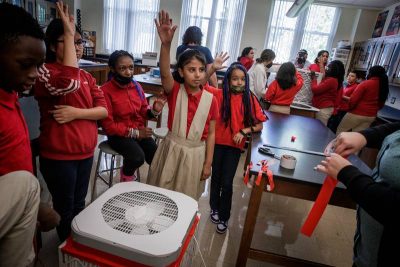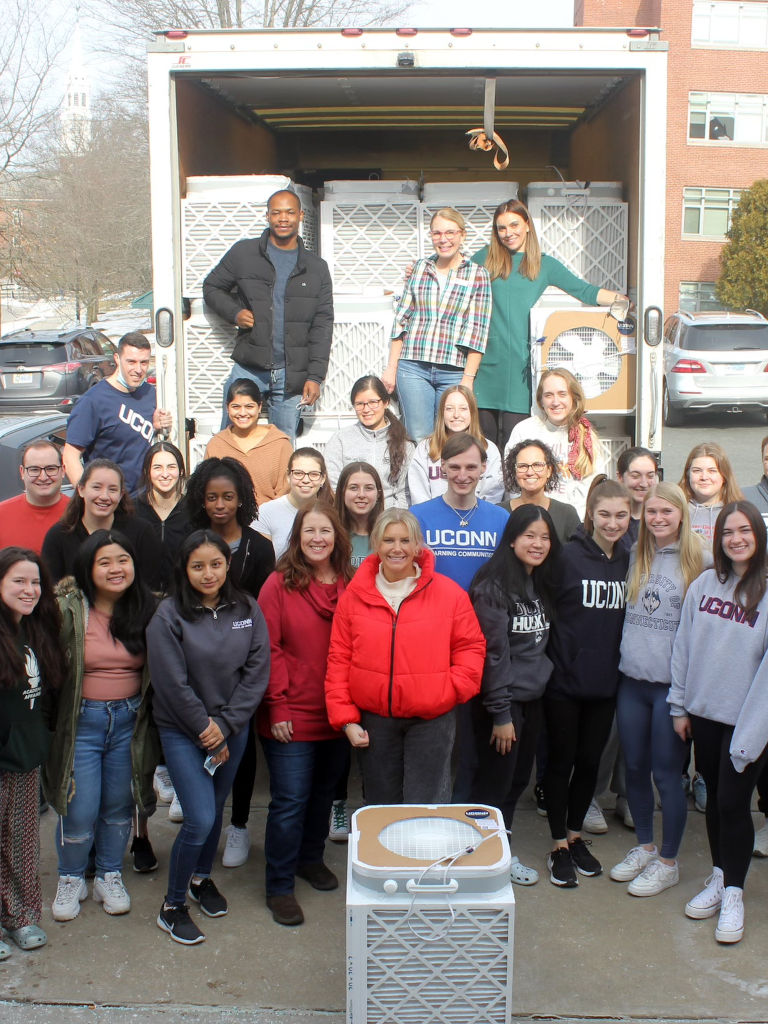There has been a paradigm shift in our understanding of how respiratory infections like COVID, RSV and the flu are transmitted – today, we know these viruses are spread through airborne transmission, and that transmission is especially high in poorly ventilated indoor spaces, including older schools and community gathering spaces. The bottom line: Improving indoor air quality is critical to our health and to our ability to learn and work at our best.
Options to Address Indoor Air Quality
 Clean air has been widely shown to enhance not only health, but also brain function and learning. Commercial HEPA air purifiers can effectively clean the air by removing the virus-laden aerosols associated with illness in children and adults. Unfortunately, these units can be cost-prohibitive, resulting in health inequality for school districts and gathering places with fewer resources.
Clean air has been widely shown to enhance not only health, but also brain function and learning. Commercial HEPA air purifiers can effectively clean the air by removing the virus-laden aerosols associated with illness in children and adults. Unfortunately, these units can be cost-prohibitive, resulting in health inequality for school districts and gathering places with fewer resources.
We believe everyone deserves clean air and the resulting positive health and learning outcomes. To that end, UConn Health and the University of Connecticut established the CLean Air Equity Response (CLEAR) Program to help Connecticut education professionals and the public learn how to easily and cost-effectively clean the air in their schools, homes, and communities with a scientifically proven, cost-effective, do-it-yourself air filtration solution called the “Corsi-Rosenthal Box”, named after its inventors Dr. Richard Corsi of UCSD and Mr. Jim Rosenthal of TexAir. This open source DIY air cleaner:
- Costs about $60 to make
- Uses the same amount of electricity as a single lightbulb
- Has been shown to clean the air as effectively as expensive HEPA air purifiers
Mission
The CLEAR Program’s mission is to create indoor air quality equity by empowering the public with the know-how to clean their own indoor air to actively reduce their exposure to airborne infectious disease, mold, dust and chemical pollutants, all of which which can worsen asthma symptoms.
In addition to sharing these crucial tools with the public, we are further studying this solution to determine how well and for how long these DIY air filters work in real world settings.
The CLEAR Program has already tested these units in an occupied university classroom and found they were effective, quiet and well-tolerated by learners and teachers when used on low speed. Testing the Efficacy of the ‘Corsi-Rosenthal’ Box Fan Filter in an Active Classroom Environment. Now we are moving outside the university environment and into K-12 classrooms and community spaces to bring this know-how to everyone in Connecticut and beyond!
Students Leading the Charge
 The CLEAR Program empowers and engages students, young scientists, and the next generation of community leaders by sharing student-created DIY air cleaners with public schools, libraries, and houses of worship – many of the spaces that currently have poor ventilation.
The CLEAR Program empowers and engages students, young scientists, and the next generation of community leaders by sharing student-created DIY air cleaners with public schools, libraries, and houses of worship – many of the spaces that currently have poor ventilation.
At UConn, that includes holding “box-a-thons” in which UConn Health and UConn students, faculty, and staff built hundreds of DIY air purifiers and donated them to poorly ventilated school districts. In our pilot district, there is now at least one air purifier in every classroom and student-occupied space. Now we are gathering systematic air quality data to better understand the tangible impact of this solution on student and staff health.
Community Focus – How to Get Involved
The CLEAR Program is focused on sharing information about DIY air purifiers with the public to drive broad adoption and give Connecticut schools and community spaces the opportunity to significantly enhance indoor air quality. Here you’ll find information about:
- How to build your own Corsi-Rosenthal boxes
- STEM/STEAM lesson plans
- Video guides on how to create and change filters
- Coverage of our team’s work
Together we can create impactful, positive changes to keep our communities healthier!
Generous Funding By
